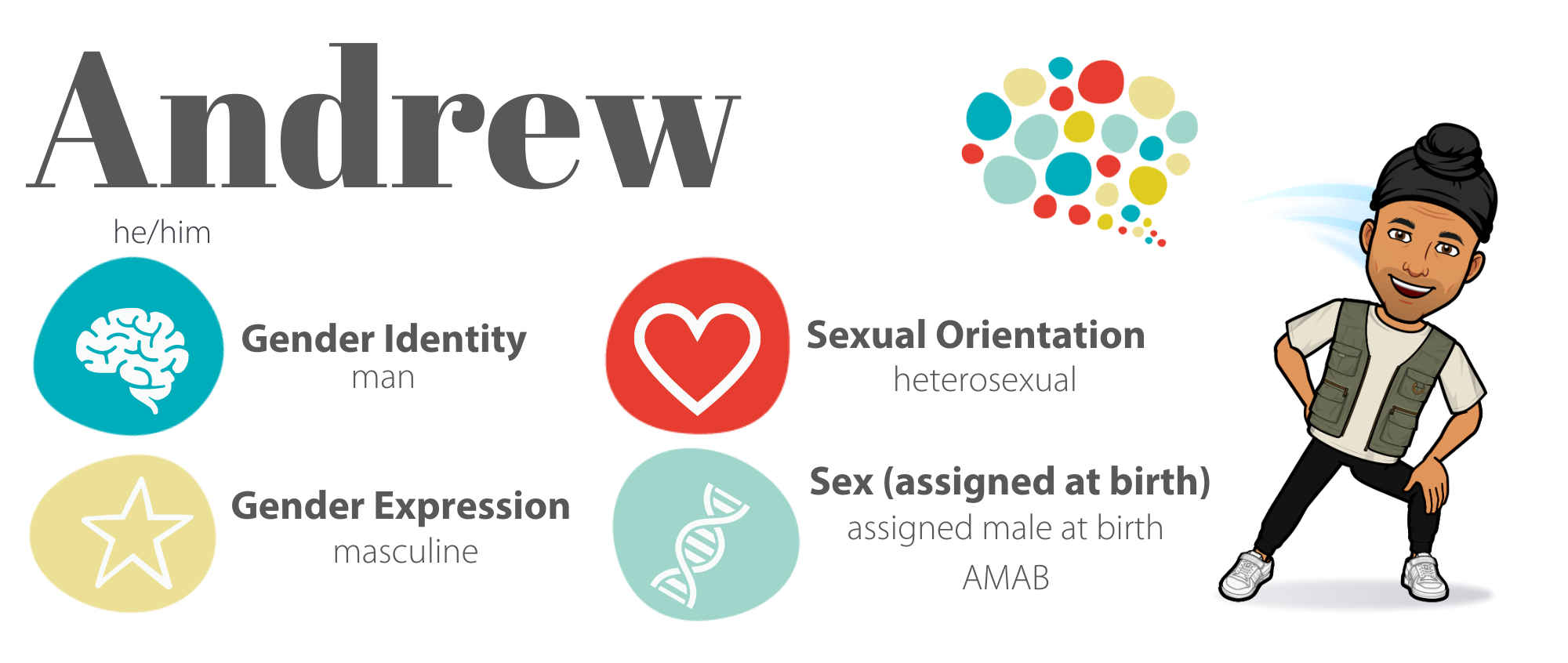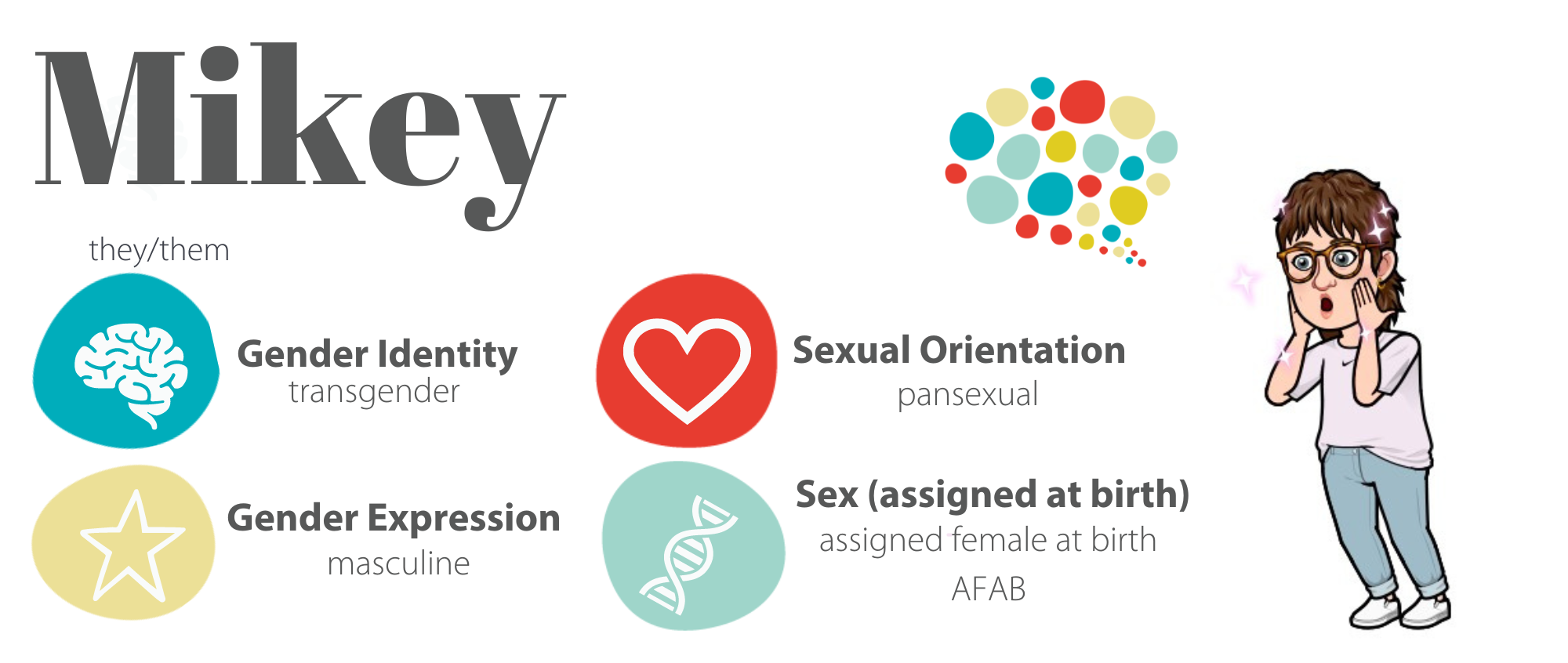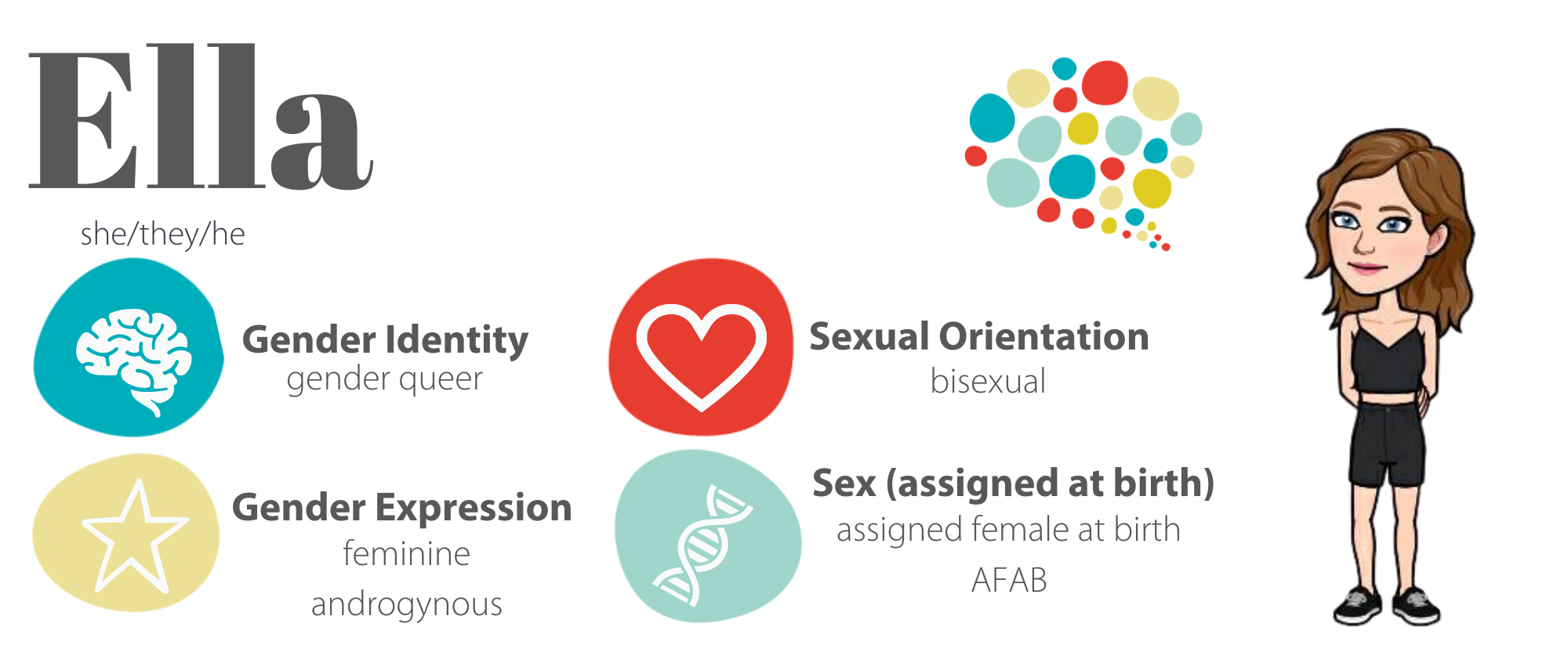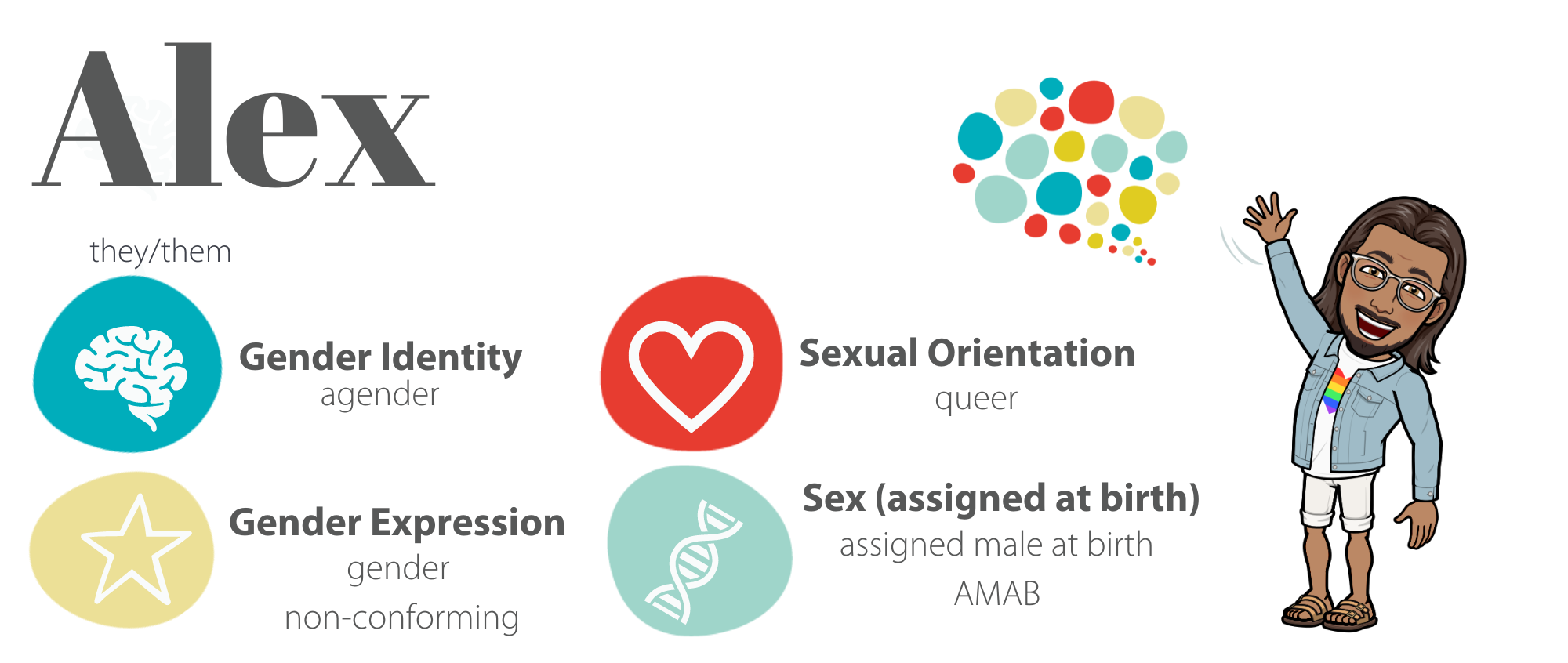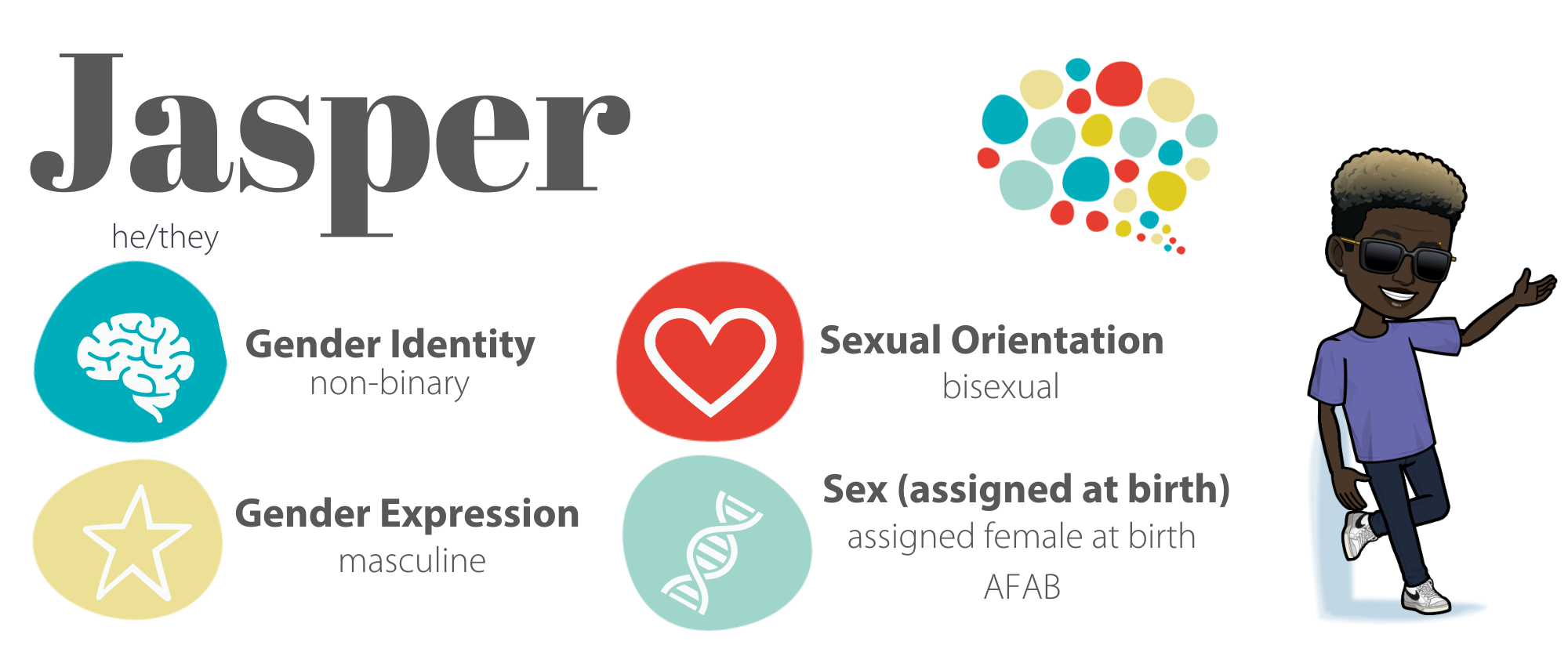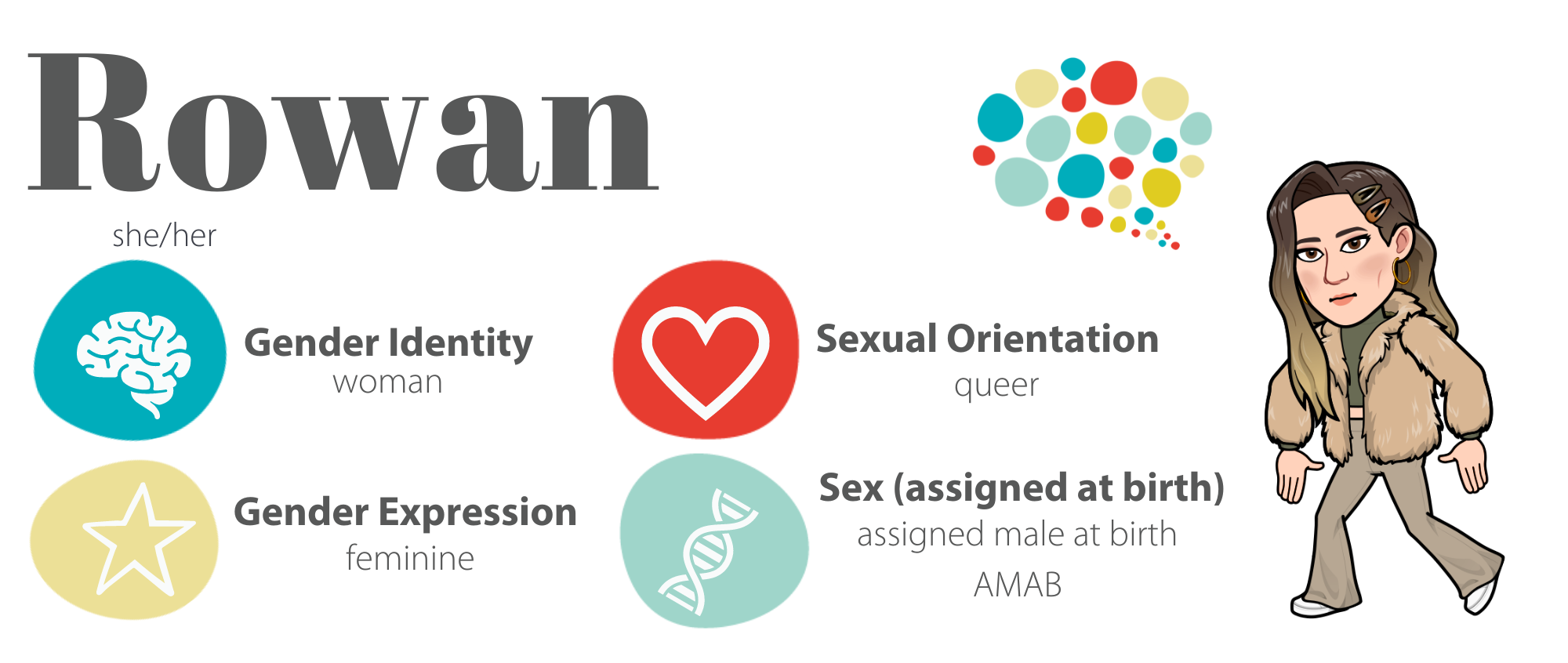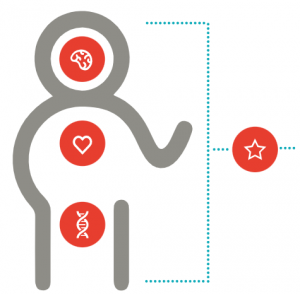Gender Identity & Expression
Everyone has a gender identity. Your gender identity is your internal, deeply held sense of being a woman, girl, man, boy, fluid among genders or no gender. Your sex doesn’t determine it and is not related to your sexual orientation (who you feel attraction to).
For many people, their gender identity matches the sex they were assigned at birth; this is called cisgender. For others, their gender identity does not match the sex they were assigned at birth. They may use terms like transgender, trans, agender, non-binary, gender fluid, gender queer, or others, to describe their gender identity. The umbrella term ‘trans’ describes people whose gender identity doesn’t match the sex they were assigned at birth. This umbrella term does not fit everyone, and it is important to listen to and use the terms people use to describe themselves.
Gender expression is about how you present yourself to the world. It includes your clothes, hairstyle, makeup, or other aspects of your appearance. It also includes your name and the pronouns you use. Some men wear makeup, and some women have facial hair. You can’t assume someone’s gender identity by looking at them.
People choose pronouns and other labels to describe their identity in ways that best align with their experiences. You can’t assume someone’s gender identity by looking at them.
The examples below show the overlapping and nuanced ways that gender identity and expression, sexual orientation and sex work together to shape someone’s identity. You can find definitions of these and other related words here.
To read more about sexual orientation, which is about who we feel attraction to, visit the page.
To see how gender identity and expression relate to sexual orientation and sex assigned at birth, see the Every Body Tool.
Many people use words that assume everyone is cisgender. This is called cisnormative language. For example:
- calling a new group of kids “boys and girls” assumes that everyone identifies as either a boy or a girl.
- having all bathrooms divided into ‘Boys’ and ‘Girls’, or ‘Men’ and ‘Women’.
- a form with only two checkboxes for gender, male and female, assumes everyone fits into one of those two options.
This wording strengthens stereotypes and assumptions about who people are and how they identify. It can make people who don’t fit these expectations feel abnormal or different. Using inclusive language avoids these assumptions. It shows that you embrace and respect diversity as a strength.
When you read about gender identity and expression, you might see acronyms like 2SLGBTQI+ or LGBT. These acronyms stand for a range of gender identities and sexual orientations. It can take some practice to remember what each letter means.
- 2S is for two-spirit
- L is for lesbian
- G is for gay
- B is for bisexual
- T is for trans/transgender
- Q is for queer and/or questioning
- I is for intersex
- +, or sometimes *, is for all the other identities that aren’t spelled out in the acronym, like non-binary, pansexual, intersex or asexual
Taken together, this acronym means sexual and gender minorities. For more on words about sexual orientation, like lesbian, gay and bisexual, see the Sexual Orientation page.
Another acronym you might encounter is SOGIE, which stands for Sexual Orientation, Gender Identity, and (Gender) Expression. SOGIE recognizes that everyone has a sexual orientation, gender identity, and a way of expressing their gender, gender expression, so it isn’t used as a replacement for 2SLGBTQI+.
Lived Experiences of Gender Diverse Youth
Many trans youth face challenges throughout their lives. They may be afraid of how their families and friends will react if they’re open about their trans identity. Making their identity public makes it more likely that someone will bully, harass or discriminate against them. Supportive families, schools, and communities play a crucial role in helping 2SLGBTQI+ children and teenagers succeed at school and in their overall well-being.
Coming out can pose serious safety risks, particularly for young people who can’t support themselves financially. Some may even be forced to leave their homes after coming out. This greatly increases their chances of substance abuse, self-harm, becoming unhoused, or dying by suicide.
Research also indicates that 2SLGBTQI+ students often do not feel safe at school. They face verbal and physical harassment and abuse from others there.
For example, in a recent survey of Canadian students (2021):
- 63% of trans students reported being harassed about their gender expression.
- 76% of trans students felt unsafe at school.
- 16% of trans students had been physically harassed or assaulted at school.
- 62% of trans students reported being excluded or left out due to their identity.
- 29% of trans students heard transphobic comments daily or weekly.
Kids and teens supported at home and school are more likely to stay in school, have stable living environments, and have better mental and physical health. When a school’s students, staff and parents ensure it is an inclusive space, 2SLGBTQI+ students can feel safe and thrive.
All kids have the right to feel safe and included in their community. If your child is the target of bullying, they and/or you should:
- tell someone they trust.
- keep a record of what’s going on (e.g., keep a record of each incident, keep examples of online bullying).
- stay safe and not fight back.
- find support with the school or broader community (e.g., join a GSA/QSA).
- know their rights as a member of the community (e.g., check out school anti-harassment policies and student code of conduct).
For more detailed tips for students, see Transphobic Bullying.
What Parents Can Do
Parents can be allies in helping their 2SLGBTQI+ child grow up healthy and resilient. Parents can help their kids learn to recognize stigma, discrimination and bullying. More importantly, they can help their kids learn ways to cope. To learn more, see Bullying.
Tips for Parents:
- Educate yourself. It’s important to educate yourself about gender diversity. There are some great online resources (see Additional Resources below) that you may find helpful. Once you have educated yourself, think about how to challenge assumptions and prejudice.
- Be a role model and set a positive example for those around you. Ensure your humour and language is supportive of the 2SLGBTQI+ community. Use gender inclusive language and don’t assume anything about another’s gender identity.
- Be supportive and respond in a positive way. It can take a lot of courage for someone to come out. If your child or teen comes out to you, be respectful, open, and non-judgmental. Let them know you’re here for them and that you love them.
- Take action. Recognize and report inappropriate behaviour or actions targeted at your child. Talk to your school if your child is being bullied or harassed.
- Get support. Find out what resources and supports may help your child and you. Offer to go with your child for in-person services so they don’t feel alone.
- Get involved. Advocate for the human and civil rights for everyone. 2SLGBTQI+ rights benefit us all. Stand by your 2SLGBTQI+ child.
- Be an ally. An ally is a person who promotes or supports the human, civil and sexual rights of sexual and gender minorities. All the points above are things you can do to be an ally for your 2SLGBTQI+ child. Let your child tell you how you can be an ally for them. Remember, even the smallest actions can bring about changes.
Gay-Straight/Gender-Sexuality/Queer-Straight Alliances (GSAs/QSAs)
Many gender diverse kids do well in their school environments and are proud of who they are. They have positive and productive coping strategies and can be role models and sources of support for other 2SLGBTQI+ students.
GSAs/QSAs are student groups found in some K–12 schools. These groups create supportive and safe environments for sexual and gender minorities and their supporters. Schools that choose to start a GSA/QSA:
- are looking for ways to create a safer school space.
- reduce bullying.
- support human rights and social justice related to sexual orientation and gender diversity.
- ensure regular meetings in a safe space, have an adult supervisor/sponsor and name the club.
To read more, see Positive Impacts of GSAs/QSAs
The Education Act in Alberta states that all schools are required to protect the establishment of a GSA/QSA with principal support in a timely manner.
If your child wants to start a GSA/QSA, they can take the following steps:
- Find a teacher or staff sponsor.
- Meet with the school administration.
- Find other students who may want to help start the group.
- Pick a meeting space.
- Advertise the group.
- Plan and hold a first meeting.
- Set up ground rules/group agreements.
- Plan for the future.
For more information on GSAs/QSAs, see the Additional Resources page.
Words You May Hear
Below is a list of common terms and definitions you may hear related to sexual and gender diversity. These terms are not labels. When speaking with people, it is important to listen to and use the terms they use to describe themselves, not impose terms on others.
- Ally: A person who advocates for the human rights of sexual and gender minority people by challenging discrimination and heterosexism.
- Agender: Someone who does not identify with a specific gender or have a recognizable gender expression.
- Cisgender/Cis: A person whose gender identity matches the sex they were assigned at birth.
- Cisnormativity: The assumption that everyone’s gender aligns with cultural expectations of the sex assigned at birth (cisgender) and that this is the norm, e.g., only women wear dresses and make-up.
- Coming Out: Telling people about one’s sexual orientation or gender identity. Also known as ‘coming out of the closet’.
- Gender Binary: The classification of sex and gender into two distinct and separate states of masculine and feminine. It’s a social boundary that discourages people from crossing or mixing gender roles.
- Gender Expression: How a person expresses their gender to the world. This can include how they look, the name they use, the pronoun they use (e.g., they, them, she, her, he, him, zie, zim) and their social behaviour.
- Gender Fluid: A person who does not identify with a single fixed gender and whose gender identity or expression may change over time.
- Gender Identity: A person’s internal sense of identity as a woman, man, both, fluid among genders, or no gender, regardless of their sex.
- Gender Queer: A person who may identify and express themselves outside what is typically associated with their sex/gender assigned at birth. People who are gender queer may not identify as trans.
- GSA/QSA (Gay-Straight/Gender-Sexuality/Queer-Straight Alliance): Student groups found in some K-12 schools. These groups create supportive and safe environments for sexual and gender minorities and their supporters.
- Inclusive Language: Language that does not assume gender (e.g., ‘partner’ instead of ‘boyfriend’ or ‘girlfriend’, ‘parent’ instead of ‘mom’ or ‘dad’, the pronoun ‘they’ instead of ‘he’ or ‘she’).
- Intersex: An umbrella term used when the reproductive, sexual or genetic biology of a person is unclear, not exclusively male or female or otherwise does not fit within traditional definitions of male or female.
- Non-binary: A person whose gender identity is not man or woman, but outside of the gender binary. Related terms include genderqueer and agender.
- Outing: Making another person’s sexual orientation or gender identity public without that person’s permission or knowledge. This can be harmful to a child or teen if they come from a non-supportive home environment.
- Queer: A reclaimed term used by some people who identify as a sexual and/or gender minority. It’s also a positive, inclusive term to describe communities and social movements.
- Questioning: A person exploring, or unsure of, their sexual orientation or gender identity.
- Sex: Categories (male, female) to which people are typically assigned at birth based on physical characteristics. Some people may be assigned intersex, when their reproductive, sexual or genetic biology doesn’t fit the traditional definitions of male or female.
- Sexual Orientation: A person’s emotional, physical and sexual attraction to others. It can change and may or may not be the same as a person’s sexual behaviour.
- Transgender/trans: An umbrella term for people whose gender identity and/or gender expression differs from what is typically associated with the sex they were assigned at birth. Some people may describe themselves using one or more of a wide variety of terms.
- Transmasculine: an umbrella term that refers to people who were assigned female at birth but identify with masculinity. It’s often abbreviated as “transmasc.” You can be masculine but not identify as a male.
- Transfeminine: an umbrella term that refers to people who were assigned male at birth but identify with femininity. It’s often abbreviated as “transfemme.” You can be feminine but not identify as a female.
- Transition: The process of changing a person’s gender presentation in society. Trans people may choose from a range of changes to express their gender such as:
- social transition that may include change of name, pronouns and expression (e.g., clothing, mannerisms, voice etc.)
- medical or surgical transition that may include hormones or gender affirming surgery.
- The journey of transition is unique to each individual. Not everyone who considers themselves trans will undergo all or any of these changes,
- Transphobia: Fear and/or hatred of people who are trans. Often shown through prejudice, discrimination, bullying, intimidation or acts of violence.
- Two-Spirit: A cultural term used by some Indigenous people to mean a person has both a male and female spirit. It may include concepts of spirituality, sexual orientation and gender identity.
See Sexual Orientation for more related terms.
Terms to Avoid & Alternatives
Tranny, She-Male, Shim, He/She, It, and other similar words: These words are offensive and dehumanize people. They should never be used. It doesn’t matter what the intent of words or actions were. If the person on the receiving end feels harassed or discriminated against, that’s what matters.
Biologically Female/Male, Genetically Male/Female, Born a Woman, Born a Man: These terms oversimplify a very complex subject. A person’s sex and gender identity are determined by several factors, not just biology or genetics. Use man, woman, boy or girl as applicable instead. On the rare occasion that it’s necessary to refer to an individual’s gender history, many transgender people prefer a phrase similar to “… assigned male at birth, but is a woman”.
Sex Change, Sex Reassignment Surgery (SRS), Pre-operative, Post-operative, Pre-op, Post-op: Referring to a “sex-change operation” or using terms such as “pre-operative” or “post-operative” suggests that one must have surgery to transition. This isn’t the case. It’s not necessary to have surgery to transition. Many transgender people don’t have surgery for a whole range of very personal reasons. It’s rude to ask a transgender person about the procedures they may or may not have had. Sex Reassignment Surgery (SRS) is an older term for the surgery(ies) some trans people undergo. It is only one small part of the transition and only for some people. Use gender confirming/ affirming/reaffirming surgery or transition instead.
Transgendered (Verb): Using transgender as a verb (e.g., transgendered) suggests that being transgender happens to a person rather than who they are. For example, we don’t say “Kalin is a gayed man”; therefore, we wouldn’t say “Joanne is a transgendered woman”. The word transgender should only be used as an adjective.
Transgender (Noun): We wouldn’t say “we have many transgenders who work here”. Nor would we use “she is a transgender”. The word transgender should only be used as an adjective. As in, “Mosi is a transgender man.”
Hermaphrodite: Hermaphrodite is no longer used. It causes stigma and has a negative history. Use intersex instead. It’s a more accurate word when a person’s biology isn’t clear.
Transgender people and normal people: The use of “normal people” in this phrase indicates a belief that transgender people are not normal. Use transgender people and cisgender people instead.
Both genders: This reinforces the false idea that only two genders can exist – a gender binary. Use all genders instead.

